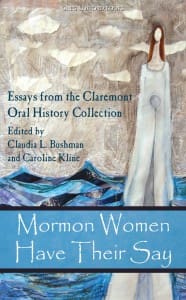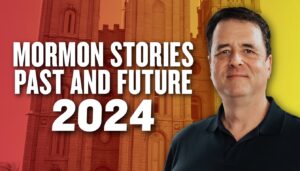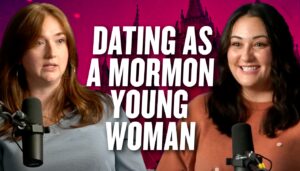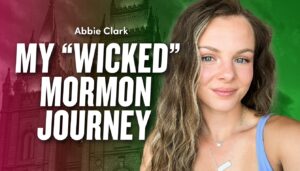 In this podcast, Heather Olson Beal interviews three essayists who contributed to the book Mormon Women Have Their Say: Essays from the Claremont Oral History Collection: Caroline Kline (who also co-edited the book with Dr. Claudia Bushman), Anna Rolapp, and Elizabeth Mott. In this podcast, we discuss the Claremont Women’s Oral History Project in general and then discuss four essays in greater depth: Caroline’s essay on Mormon women’s conceptions of the self, Anna’s essay on Mormon women and California’s Proposition 8, Elizabeth’s essay on Mormon single women, and Caroline’s essay on Mormon women’s attitudes towards and feelings about patriarchy.
In this podcast, Heather Olson Beal interviews three essayists who contributed to the book Mormon Women Have Their Say: Essays from the Claremont Oral History Collection: Caroline Kline (who also co-edited the book with Dr. Claudia Bushman), Anna Rolapp, and Elizabeth Mott. In this podcast, we discuss the Claremont Women’s Oral History Project in general and then discuss four essays in greater depth: Caroline’s essay on Mormon women’s conceptions of the self, Anna’s essay on Mormon women and California’s Proposition 8, Elizabeth’s essay on Mormon single women, and Caroline’s essay on Mormon women’s attitudes towards and feelings about patriarchy.
From amazon.com:
The Claremont Women’s Oral History Project has collected hundreds of interviews with Mormon women of various ages, experiences, and levels of activity. These interviews record the experiences of these women in their homes and family life, their church life, and their work life, in their roles as homemakers, students, missionaries, career women, single women, converts, and disaffected members. Their stories feed into and illuminate the broader narrative of LDS history and belief, filling in a large gap in Mormon history that has often neglected the lived experiences of women. This project preserves and perpetuates their voices and memories, allowing them to say share what has too often been left unspoken. The silent majority speaks in these records. This volume is the first to explore the riches of the collection in print. A group of young scholars and others have used the interviews to better understand what Mormonism means to these women and what women mean for Mormonism. They explore those interviews through the lenses of history, doctrine, mythology, feminist theory, personal experience, and current events to help us understand what these women have to say about their own faith and lives.
Other essays address important topics, such as fertility, motherhood, adversity, womanliness, callings, revelation, missions, agency, the Relief Society, and Heavenly Mother.
Please support Mormon Stories by purchasing the book through this link.




8 Responses
Thank you for sharing about this book. I loved the conversation and hearing confident women talking about strategies for change is empowering. I currently serve as a ward Relief Society president and I constantly struggle with many similar issues, but often don’t know how to approach them. Thank you for what you are doing to help mentor those of us who aren’t quite as brave or strong.
One correction…one of the women talked about Eliza R. Snow being a single woman. She was married to Joseph Smith and Brigham Young. So I’m confused why she was held up as a model of single womanhood. Could someone clarify for me? Thank you.
I was thinking the same thing about Eliza being married to both Joseph and Brigham.
But she did live an essentially single lifestyle, which is pertinent to the discussion.
Eliza R Snow wasn’t single. She was married to Joseph Smith and Brigham Young. I was disturb that the point was made that she was single and no one disputed it. Clarify please. Thanks.
I enjoyed and appreciated this podcast (and as a result bought a few copies of the book for Mother’s Day gifts for family!). So, thank you for making it available to all of us.
I’m sorry to make this thread sound like a broken record, but that was my one nit-picky point as well: That Eliza Snow was a married woman. It could be as simple as the panel members saying, “Eliza R. Snow, who was married to Joseph Smith and Brigham Young, but who essentially lived her day to day life as a single woman…”
Enjoyed this conversation very much. Thank you, ladies!
Research shows women to be better communicators and CEOs. It does not make sense that priesthood authority is based on anatomy. Some people are born with a mixed anatomy. Others have a male body but psychologically, are a woman.
Historically, female-centered religion, the goddess, was wiped out by male hierarchy and weaponry. In Old Testament times, non-virgins were killed and virgins were divided among the warriors and priests, with God getting His ten percent.
Then too, when you think of it seriously, priesthood power comes from designated authority and role playing rather than spiritual. The spiritual power comes from the imagination. The actual power of the priesthood comes not from God but from a well-organized male hierarchy with a chain-of-command.
Mormons should capitalize on one of their unadvertised, un-talked about beliefs, which would give them a reason for ordaining women. They have the Mother in Heaven. What a terrific religion this would be. A modern main-stream religion with a Goddess. Indeed, life-renewal is the theme of Christianity. And think about this. It is women who carry the life-renewing mechanism. Men can only worship from the outside.